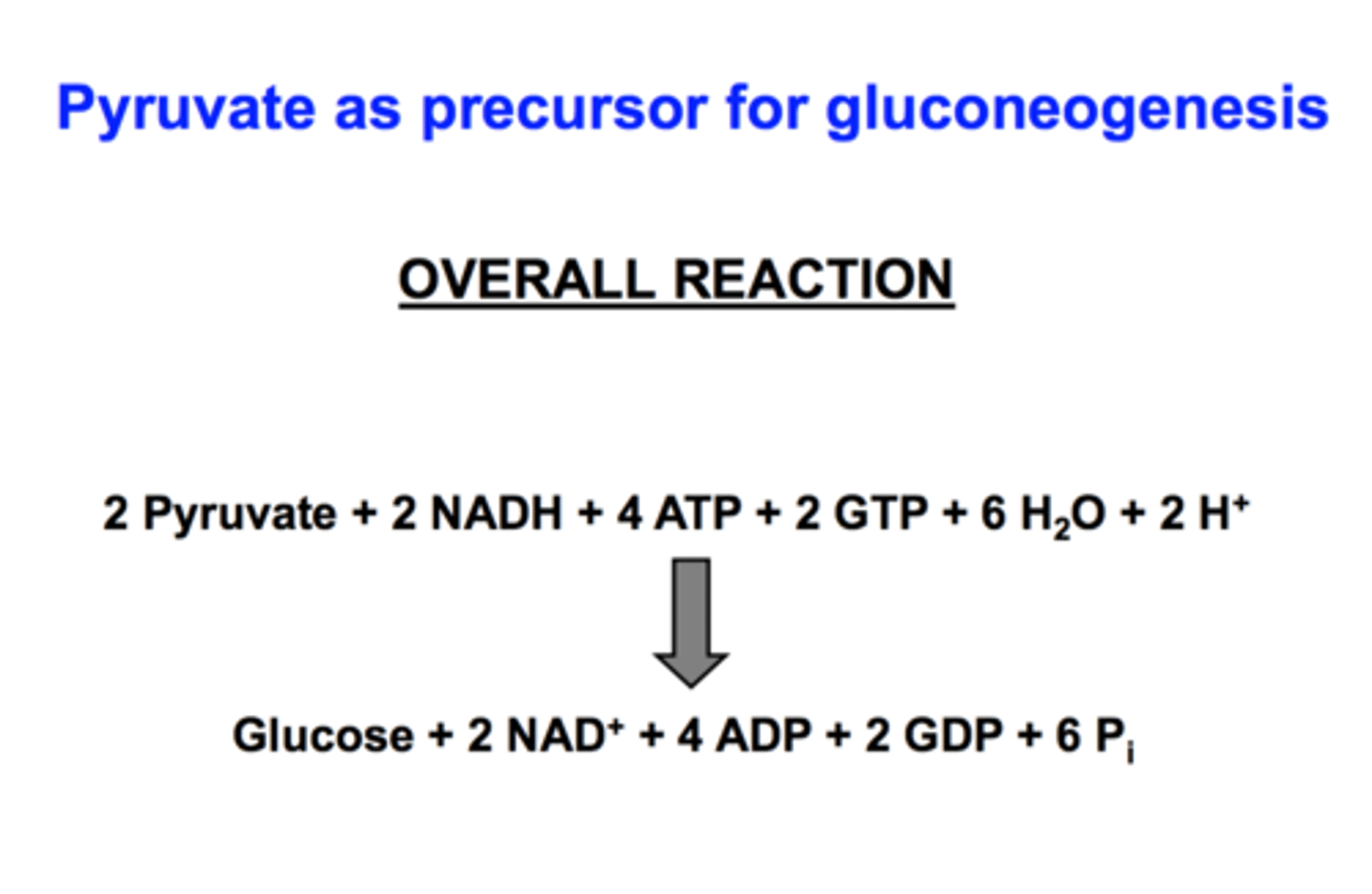Gluconeogenesis
1/25
There's no tags or description
Looks like no tags are added yet.
Name | Mastery | Learn | Test | Matching | Spaced |
|---|
No study sessions yet.
26 Terms
Gluconeogenesis
pathway that converts pyruvate and related 3-4 carbon compounds to glucose
Step 1 of first bypass rxn
pyruvate is transported from the cytosol into mitochondria or generated from alanine w/in mitochondria by transmit
Step 2 of first bypass rxn
pyruvate carboxylase converts pyruvate to oxaloacetate
- requires the coenzyme biotin

Step 3 of first bypass rxn
malate dehydrogenase uses NADH to reduce oxaloacetate to malate
Step 4 of first bypass rxn
malate leaves the mitochondria through a malate transporter in the inner mitochondria membrane, then reoxidized to oxaloacetate
Step 5 of first bypass rxn
phosphoenolpyruvate carboxykinase converts oxaloacetate to PEP
- requires Mg2+ and GTP

Second bypass rxn
fructose1,6-bisphosphatase (FBPase-1) converts fructose 1,6-bisphosphate to fructose 6-phosphate by hydrolysis of the C-1 phosphate
- requires Mg2+
Third bypass rxn
glucose 6-phosphate catalyzes the simple hydrolysis of glucose 6-phosphate to glucose
- requires Mg2+
- only found in the lumen of the ER of hepatocytes, renal cells, and epithelial cells of the small intestine
Equation of gluconeogenesis
2 pyruvate + 4ATP + 2GTP + 2NADH + 2H+ + 4H2O -----> glucose + 4ADP + 2GDP + 6Pi + 2NAD+

Glucogenic amino acids
amino acids able to undergo net conversion to glucose
Glyceroneogenesis
conversion of pyruvate to dihydroxyacetone phosphate via the early reactions of gluconeogenesis, followed by a reduction of glycerol 3-phosphate
- carries out of adipocytes
How are glycolysis and gluconeogenesis reciprocally regulated?
simultaneous operation of both pathways at each point of the 3 bypass points would consume ATP w/out accomplishing chemical or biological work. regulation prevents wasteful operation of both pathways at the same time
How are hexokinases affected by glucose 6-phosphate?
- hexokinase 1,2, and 3 are all inhibited by their product
- hexokinase 4 in the liver is not inhibited
Kinetic properties of hexokinase 4
Km is higher than the usual glucose concentration
Citrate
key intermediate in the aerobic oxidation of pyruvate, FAs, and AAs
How does citrate allosterically regulate PFK-1?
- high concentrations increase the inhibitory effect of ATP
- serves as an intracellular signal that the cell is meeting its current needs for energy-yielding metabolism by the oxidation of fats and proteins
How is FBPase-1 allosterically inhibited by AMP?
- high AMP corresponds to low ATP, slows glucose synthesis
- high ATP glows glycolysis and speeds gluconeogenesis
Glucagon
hormone that signals the liver to produce and release more glucose and to stop consuming it
- released when blood glucose level decreases
insulin
hormone that signals the liver to use glucose as a fuel and as a precursor for the storage of glycogen and triacylglycerol
fructose 2,6-bisphosphate
mediates the rapid hormonal regulation of glycolysis and gluconeogenesis
- binds to PFK-1 and increases its affinity for fructose 6-phosphate
- binds to FBPase-1 and reduces its affinity for its substrate
phosphofructokinase-2
(PFK-2) catalyzes the formation of fructose 2,6-bisphosphate
fructose 2,6-bisphosphate
(FBPase-2) catalyzes the breakdown of fructose 2,6-bisphosphate
xylulose 5-phosphate
an intermediate of the pentose phosphate pathway that activates phosphoprotein phosphatase 2A
phosphoprotein phosphatase 2A
dephosphorylates the bifunctional PFK-2/FBPase-2 enzyme
- causes an increase in fructose 2,6-bisphosphate
Role of acetyl-CoA in gluconeogenesis
- allosterically stimulates pyruvate carboxylase
- allosterically inhibits pyruvate dehydrogenase
ChREBP (carbohydrate response element binding protein)
transcription factor expressed in liver, adipose tissue, and kidney
- acts in the nucleus to regulate gene expression for genes coding for enzymes needed for carbohydrate and fat synthesis